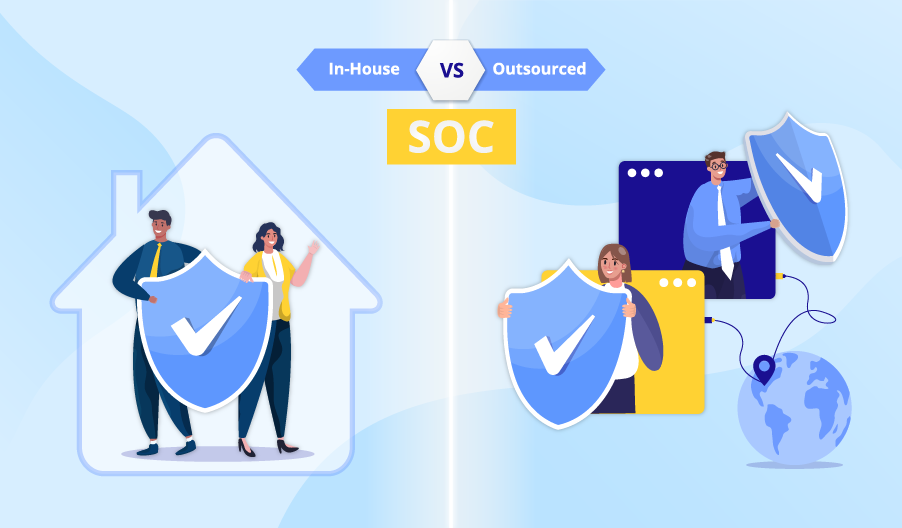In-House vs. Outsourced SOC: Finding the Right Cybersecurity Strategy
Editor’s note: Dmitry compares in-house and outsourced SOCs and analyzes the key factors that may influence your choice of sourcing model. If you’re looking for a mature SOC partner to help you secure your business operations, don’t hesitate to contact ScienceSoft for our cybersecurity services.
A Security Operations Center (SOC) is a centralized IT facility or team responsible for monitoring, detecting, assessing, and responding to cybersecurity threats and incidents. The primary goal of a SOC is to protect an organization’s digital assets, including data, networks, and systems, from various cyber threats, including malware, hacking attempts, and data breaches.
An in-house SOC is a dedicated IT unit within the organization that operates and maintains its own security tools and processes. An outsourced SOC is an external team provided by a third-party vendor that monitors, detects, and responds to cybersecurity threats on behalf of a client organization.

The Pros and Cons of an In-House SOC
Pros
- Control. Organizations have direct control over their internal SOC’s operations, allowing them to tailor security practices and policies to their specific needs and preferences.
- In-depth knowledge. Internal security teams develop a deep understanding of the organization’s systems, data, and unique security challenges, enabling more accurate threat detection and response.
- Immediate response. In-house SOCs can respond quickly to security incidents because they are present on-site and have immediate access to the organization’s infrastructure.
- Flexibility. The organization can customize its SOC tools and technologies to fit its infrastructure and security needs.
Cons
- High cost. Setting up and maintaining an in-house SOC can be expensive due to the need for skilled personnel, advanced security tools, and ongoing training.
- Limited scalability. In-house SOCs can be difficult to scale to handle increased workloads or sudden spikes in cyber threats.
- Expertise gaps. It may be challenging for smaller organizations to attract and retain top cybersecurity talent, potentially leaving them vulnerable to advanced threats.
- Internal bias. In-house SOC teams may have internal biases or cultural factors that affect their ability to assess threats objectively. Outsourced providers can offer a more independent perspective.
The Pros and Cons of an Outsourced SOC
Pros
- Cost efficiency. Outsourcing a SOC is usually more cost-effective because it eliminates the need for in-house infrastructure, tools, and cybersecurity talent hiring and training. Organizations can access SOC services at a predictable subscription cost or use the Time&Material model to only pay for the actual work done.
- Access to expertise. External providers typically employ a team of experienced cybersecurity professionals with diverse skill sets. Clients benefit from access to a broader range of expertise than they could maintain in-house.
- 24/7 monitoring. Many outsourced SOCs offer round-the-clock monitoring and threat detection, ensuring continuous protection against cybersecurity threats, even during off-hours.
- Advanced technologies. External providers invest in state-of-the-art security technologies and tools, giving clients access to cutting-edge solutions without significant capital expenditures.
Cons
- Privacy concerns. Sharing sensitive data with an external provider can raise privacy and security concerns, especially for organizations in highly regulated industries. A SOC vendor should be able to prove its mature approach to data security, which is usually guaranteed by certifications such as ISO 27001.
- Standardization. Outsourced SOCs often offer off-the-shelf security solutions that may not be fully customizable to meet a client organization’s needs. It is important to review a potential vendor’s service level agreements and portfolio projects to gather how flexible they are with each client.
- Dependency. Relying on an external provider means being dependent on their services and responsiveness, which can potentially lead to delays or issues in incident response times. To find a reliable vendor, seek client references and understand their escalation procedures for addressing delays and service interruptions.
- Communication challenges. There may be communication challenges between the client and the outsourced SOC, especially if there are language barriers or time zone differences. A mature SOC provider would provide a clear and efficient communication protocol, including multilingual support and well-defined processes for addressing time zone discrepancies.
In-House or Outsourced Cybersecurity: Which One to Choose?
When deciding between an in-house or outsourced SOC, consider your organization’s size, budget, security priorities, and risk tolerance. Some organizations opt for a hybrid approach, combining elements of both options to strike the right balance for their unique needs.
Regardless of the sourcing method, the SOC plays a crucial role in defending against evolving cyberthreats and ensuring the overall security of an organization. If you need a reliable SOC provider able to keep up with the ever-changing threat landscape and protect your business from cyberattacks, contact ScienceSoft.

